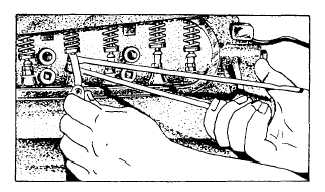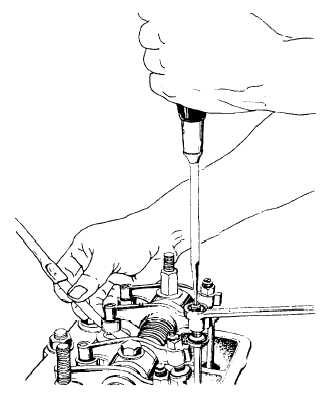shown in figure 3-13. On engines with stud- mounted rocker arms, make the adjustment by turning the stud nut.
Valves in Block
This type of valve arrangement is not commonly seen in the field; however, we will describe the adjustment procedure in case you should happen to run across this type.
Valves within the block are generally adjusted "cold" that is, recommended valve clearance are given for a cold engine. These valves have mechanisms quite similar to those of overhead valves. They are adjusted by removing the side plates, usually found beneath the intake manifold on the side of the engine block (fig. 3-14). Since you must stop this engine to adjust the valves, the piston in the cylinder to be adjusted must be on TDC of the compression stroke. You can determine this by watching the valves of the piston that is paired with the one that is being set. As the cylinder that is being positioned is coming up on the compression stroke, the paired cylinder will be coming up on the exhaust stroke. Therefore, an exhaust valve will be open. Just as the exhaust

Figure 3-14. - Adjusting valve in block.
valve closes and the intake valve begins to open, the cylinder that is to be set will be on TDC of the compression stroke, and you can set the two valves. Once the No. 1 cylinder is positioned, follow through according to the firing order of the engine, as this makes the job easier and faster. You may also use this procedure when adjusting valves on overhead valve engines.
Hydraulically Operated Valves
On engines equipped with hydraulic valve lifters (fig. 3-1 5), it is not generally necessary to

Figure 3-13. - Adjusting overhead valves.

Figure 3-15. - Hydraulic valve lifter.
Continue Reading